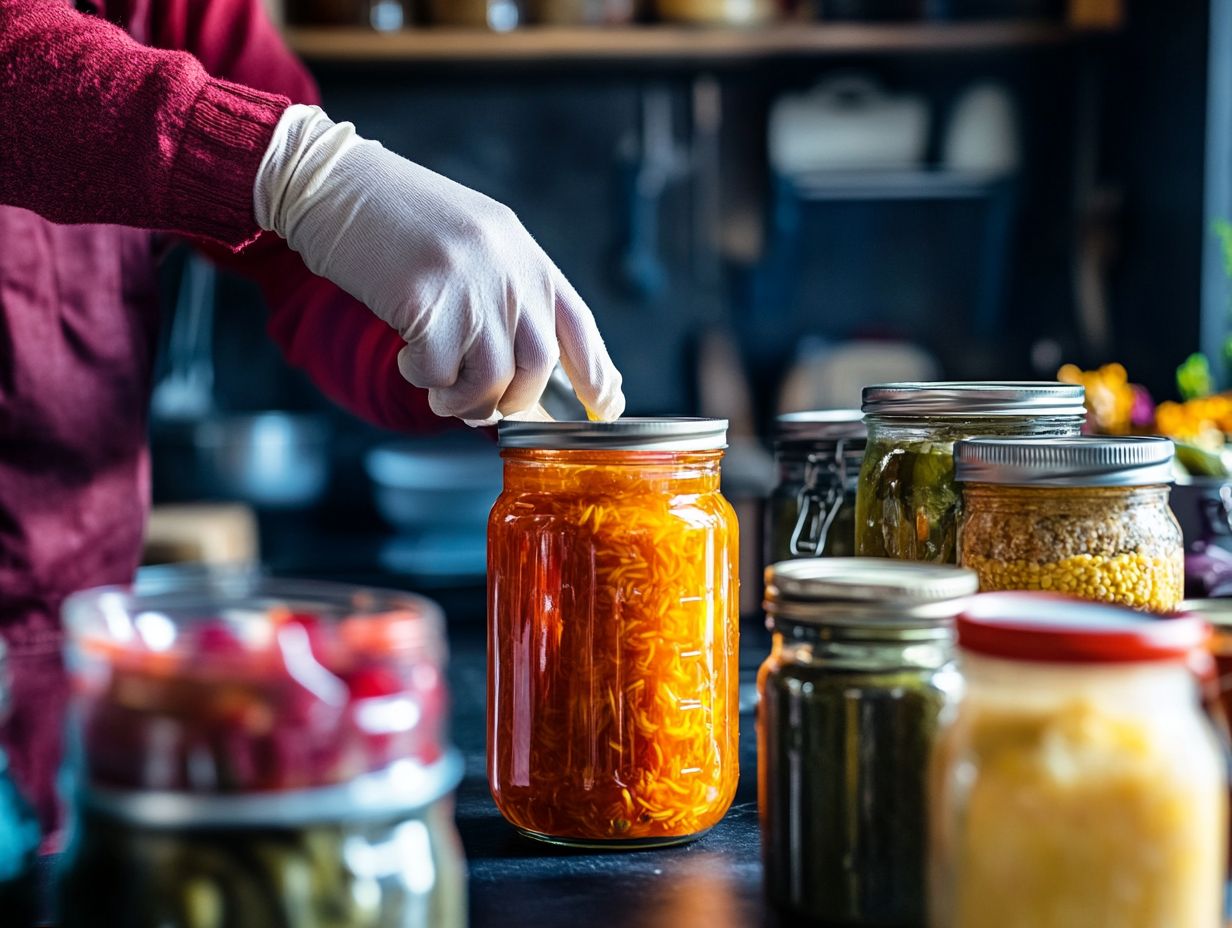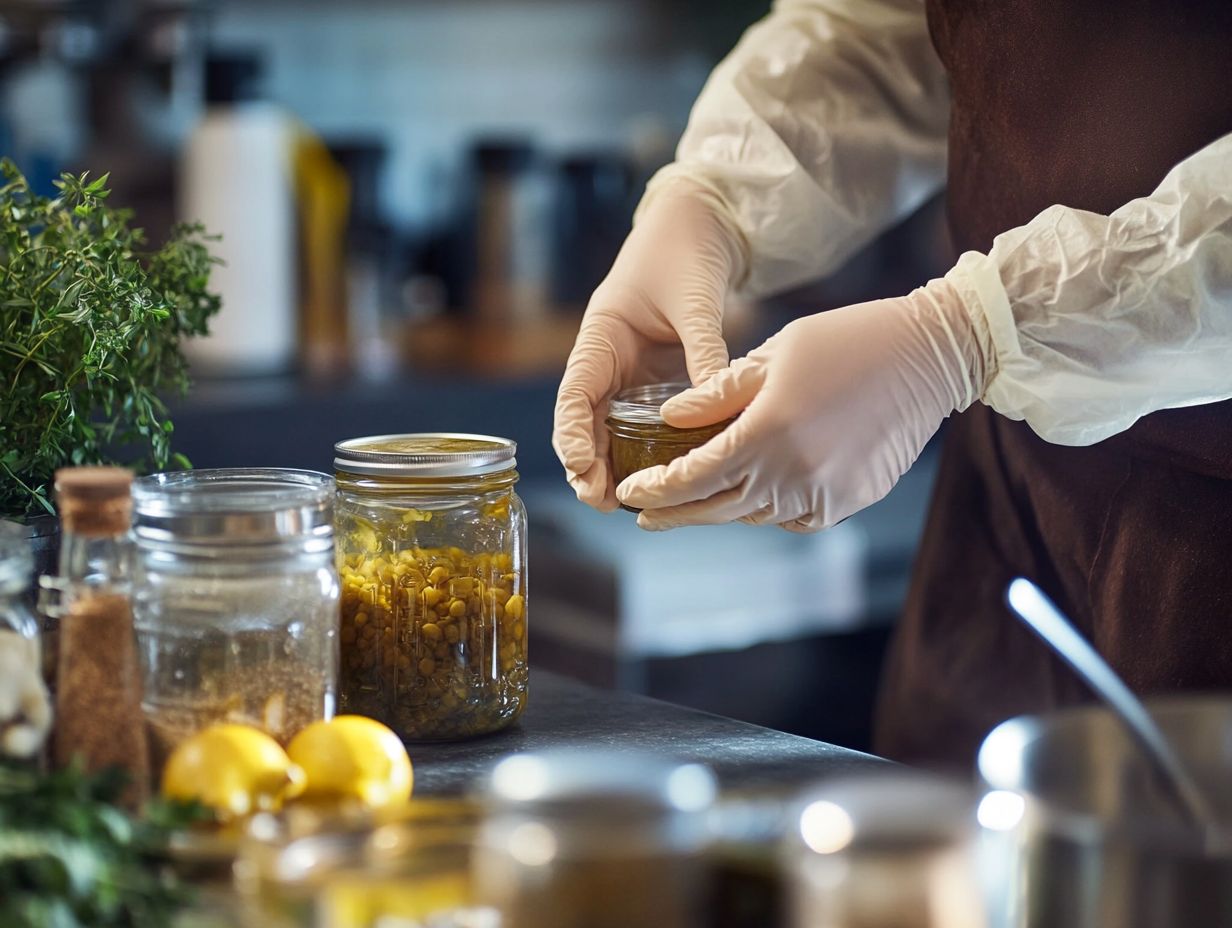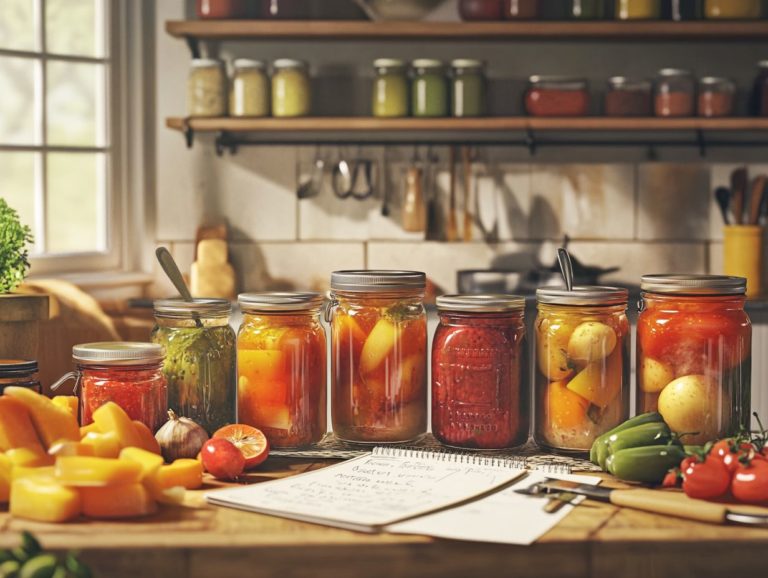Troubleshooting Botulism Risks in Canning
Botulism is a serious and potentially life-threatening illness that can arise from improperly canned foods.
In this guide, you will learn the essentials of botulism what it is, how it spreads, and the specific risks tied to the canning process. We ll also cover safe canning techniques for both high-acid and low-acid foods. You’ll explore common causes, identify warning signs in canned goods, and discover best practices for safe canning.
We will outline steps to take if you suspect botulism, empowering you with the knowledge needed to safeguard yourself and your loved ones.
Contents
- Key Takeaways:
- What You Need to Know About Botulism
- The Risks of Botulism in Canning
- Preventing Botulism in Canning
- What to Do if You Suspect Botulism
- Frequently Asked Questions
- What is botulism and how is it related to canning?
- How can I prevent botulism when canning food at home?
- What are the signs and symptoms of botulism poisoning?
- How can I tell if my canned food is contaminated with botulism?
- What do I do if I suspect botulism contamination in my canned food?
- Is botulism always a risk when canning food at home?
Key Takeaways:

- Botulism is a rare but serious illness caused by a toxin from the bacteria Clostridium botulinum. This bacteria often grows in improperly canned food.
- Canned foods, especially low-acid ones, that are not processed or stored properly can lead to the growth of this bacteria.
- To prevent botulism when canning at home, always follow proper techniques, use clean equipment, and check for contamination signs before consuming canned foods.
What You Need to Know About Botulism
Knowing about botulism is vital for anyone who enjoys preserving food, especially through home canning. This serious form of food poisoning stems from toxins produced by the bacterium Clostridium botulinum, which can flourish in improperly canned goods particularly low-acid foods like vegetables and meats.
Many may not realize that this deadly toxin can result in life-threatening illnesses if food safety protocols are ignored. By understanding the risks associated with botulism and referring to troubleshooting canning jar preparation, you not only improve your canning skills but also protect the well-being of everyone enjoying your homemade creations.
What is Botulism?
Botulism is a rare yet potentially fatal illness caused by a neurotoxin produced by the bacterium Clostridium botulinum. This toxin is among the most potent known to humanity and can appear in several forms, including foodborne, wound, and infant botulism.
Foodborne botulism usually arises from eating improperly preserved or canned foods, where the toxin has a chance to grow. Wound botulism occurs when the bacterium infects a wound, allowing the toxin to enter the bloodstream. Infant botulism affects babies who ingest spores, leading to toxin production in their intestines.
The neurotoxin disrupts nerve and muscle communication by blocking the release of acetylcholine, which can result in paralysis and severe complications. Awareness and prevention are crucial.
How Does Botulism Spread?
Botulism primarily spreads through eating improperly canned or preserved foods that contain Clostridium botulinum spores. These spores thrive in low-acid environments.
They prefer environments without oxygen, making poorly canned goods particularly vulnerable. Always be on the lookout for signs of spoilage, such as bulging cans, unusual odors, or discoloration.
Following USDA guidelines is essential for reducing these risks, as they provide critical recommendations for safe canning practices. For example, using pressure canners for low-acid foods ensures high-temperature processing to eliminate spores effectively.
Whether you’re making home-canned vegetables or opting for store-bought options, maintaining vigilance in food preparation and storage is key to preventing botulism. If you’re specifically working with fruit, it’s helpful to know about troubleshooting soft fruit in canning to ensure safety and quality.
The Risks of Botulism in Canning
The risks associated with botulism in canning are serious and must not be overlooked. To avoid issues, it’s important to follow safe practices and consult resources on troubleshooting common canning problems. Improper techniques can allow the growth of Clostridium botulinum, especially in low-acid foods like vegetables and meats.
Many home canners underestimate the importance of following safety guidelines, leading to potentially disastrous outcomes. For guidance on ensuring safety, consider troubleshooting your canning process. Botulism can result in severe food poisoning, posing serious health risks for anyone consuming contaminated canned goods.
Understanding these risks is vital for anyone passionate about food preservation through canning.
Why Botulism Occurs in Canned Foods

Common causes of botulism in canned foods often result from improper canning methods, especially when processing low-acid foods that haven’t been adequately treated.
This issue becomes serious when home canners use boiling water baths. These are not safe for low-acid items like green beans or corn.
A study found that nearly 15% of reported botulism cases were associated with homemade foods that were improperly processed.
One infamous case is the 1977 outbreak that affected a group of individuals who consumed improperly canned chili, leading to multiple hospitalizations and dire consequences. Being aware of these practices is essential for ensuring safe home canning.
Identifying Signs of Botulism in Canned Foods
Identifying signs of botulism in canned foods is essential for ensuring food safety and preventing foodborne illness, especially when you know how to troubleshoot canning equipment malfunctions.
When inspecting cans, pay particularly close attention to visual indicators like bulging or swollen lids; these are telltale signs of gas buildup within the container.
Trust your senses. Off-odors, often described as sour or rancid, can indicate potential contamination. Similarly, unusual textures, such as those that are excessively slimy or mushy, should raise immediate concerns.
These sensory cues are crucial for maintaining safety standards; even seemingly minor abnormalities can signal the presence of harmful bacteria.
Therefore, implementing proper inspection practices becomes invaluable in mitigating the risks associated with consuming contaminated products.
Preventing Botulism in Canning
Preventing botulism is crucial for safe food preservation. Start by understanding safe canning methods and proper techniques, and consult resources on troubleshooting pressure canning issues to ensure your process is effective.
Using a pressure canner for low-acid foods and adhering to USDA guidelines for processing times can significantly minimize the risks of contamination and foodborne illness.
Knowing the signs of spoilage is crucial. Regularly inspecting the seals and integrity of your canned jars is vital. With these proactive measures in place, you can enjoy homemade foods without the looming fear of botulism.
Proper Canning Techniques
Proper canning techniques ensure the safety of preserved foods, especially when using a pressure canner for low-acid foods or a boiling water bath for high-acid foods.
To embark on your canning journey, start by thoroughly sterilizing your jars and lids. You can easily do this by submerging them in boiling water for a few minutes.
When choosing the right method, consider the acidity of the food. For instance, tomatoes and most fruits, like peaches, are perfect candidates for a boiling water bath, while green beans and corn require a pressure canner to effectively eliminate harmful bacteria.
Understanding the specific pressure settings on your canner is crucial, as these can vary by altitude and type of food. This way, you ll ensure each batch is not only safe but also delicious.
Safety Measures to Follow
Adhering to key safety measures is absolutely vital for anyone engaged in home canning to prevent botulism and ensure overall food safety. Additionally, being aware of troubleshooting canned pickle problems can help you address any issues effectively.
To achieve this, select the right ingredients opt for fresh, high-quality produce and understand the acidity levels required for safe preservation.
Monitoring processing times for different recipes is critical; under-processing can lead to hazardous outcomes. Ensuring that jars are properly sealed free of bubbles or cracks is another fundamental safety step you can’t overlook.
You can significantly enhance your canning experience by tapping into educational resources offered by reputable organizations like the USDA and the National Center for Home Food Preservation. These resources provide valuable guidelines on best practices, ultimately leading to better results and greater peace of mind.
What to Do if You Suspect Botulism

If you suspect botulism from consuming canned foods, act quickly every moment counts! This condition can escalate into a medical emergency if left untreated.
You might experience symptoms such as dizziness, double vision, difficulty swallowing, and muscle weakness. These are clear signs that the toxin affects your nervous system.
Seeking immediate medical attention is essential. Prompt intervention can greatly enhance your chances of recovery.
Inform healthcare professionals about the suspected food source. This allows them to deliver the appropriate treatment and guidance for your ongoing care.
Symptoms and Treatment
The symptoms of botulism can appear swiftly. You may encounter blurred vision, difficulty swallowing, and muscle weakness all of which demand immediate medical attention.
As the illness advances, you might find yourself grappling with fatigue, double vision, and potentially life-threatening respiratory difficulties. Recognizing these signs early is paramount.
Prompt diagnosis is essential for effective treatment. Healthcare providers typically recommend a treatment to counteract the toxin as the initial line of defense.
In more severe cases, hospitalization staying in a medical facility for treatment may be necessary to deliver supportive care. This includes respiratory assistance or intravenous fluids, ensuring you receive comprehensive treatment to facilitate your recovery.
When to Seek Medical Attention
Recognizing the signs of a potential medical emergency is crucial regarding suspected botulism. Immediate intervention can be life-saving.
If you experience symptoms like double vision, difficulty swallowing, or severe muscle weakness, seek urgent medical care without hesitation. These symptoms can escalate quickly into more serious conditions, such as respiratory distress, which demands a rapid response.
When you contact healthcare professionals, provide accurate information about the suspected contaminated food source. This will assist them in diagnosing and treating your condition promptly.
Timely reporting of these indicators aids your recovery and plays an essential role in public health efforts to prevent further cases.
Frequently Asked Questions
Botulism is a type of food poisoning caused by a bacteria called Clostridium botulinum. It can be related to canning because improperly canned food provides the perfect environment for the bacteria to grow and produce toxins.
How can I prevent botulism when canning food at home?

The best way to prevent botulism is by following proper canning methods and guidelines. For more insights, refer to understanding canning process failures. Use a pressure canner for low-acid foods, such as vegetables and meats, and follow the recommended processing times and temperatures.
What are the signs and symptoms of botulism poisoning?
The most common symptoms of botulism include nausea, vomiting, blurred vision, difficulty swallowing and speaking, and muscle weakness. In severe cases, it can lead to paralysis and even death.
How can I tell if my canned food is contaminated with botulism?
If you notice any unusual or foul odors, changes in color or texture, or bulging lids on your canned food, do not consume it. These are signs of potential contamination with botulism, and the food should be discarded.
What do I do if I suspect botulism contamination in my canned food?
If you suspect that your canned food may be contaminated with botulism, do not consume it. Contact your local health department for guidance on proper disposal and next steps.
It is important to also seek medical attention if you have any symptoms of botulism poisoning.
Is botulism always a risk when canning food at home?
No, botulism is not always a risk when canning food at home. By using the right canning methods, including understanding issues like canning liquid separation, you can significantly lower the chance of contamination.
Botulism is a serious illness caused by bacteria that can thrive in improperly canned foods. Always follow recommended guidelines to stay safe.






